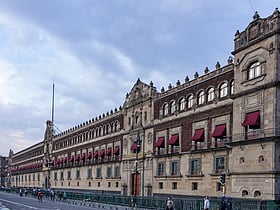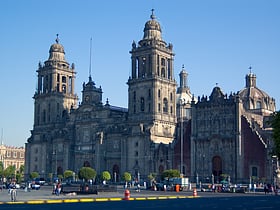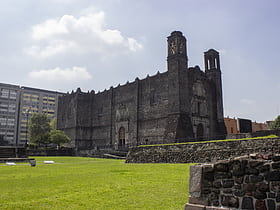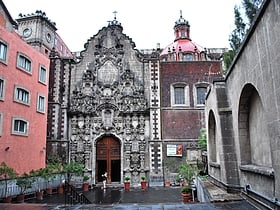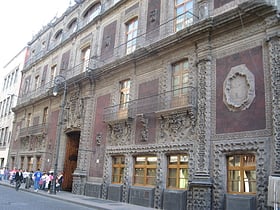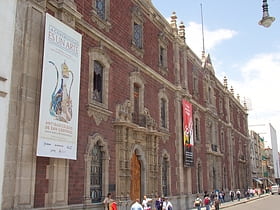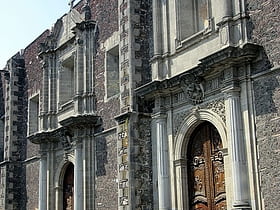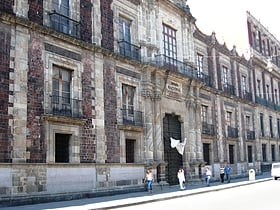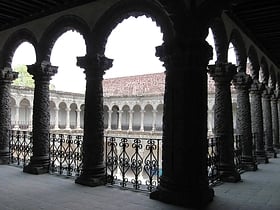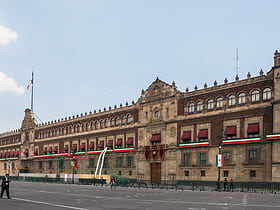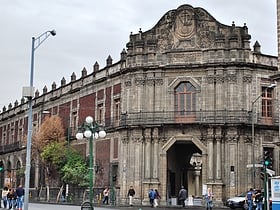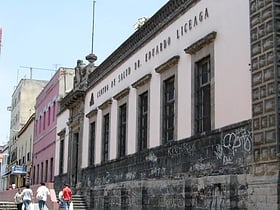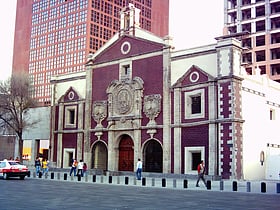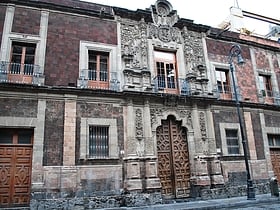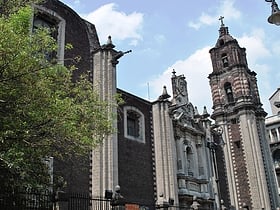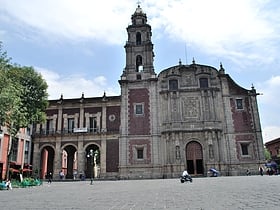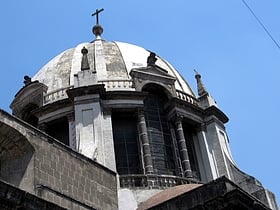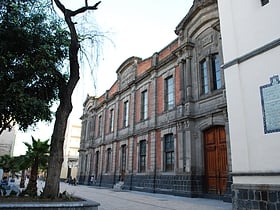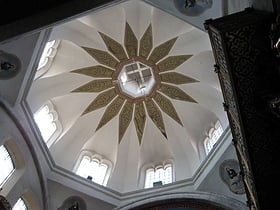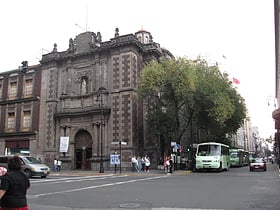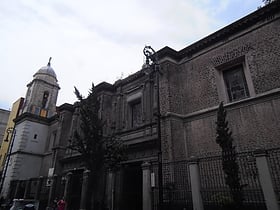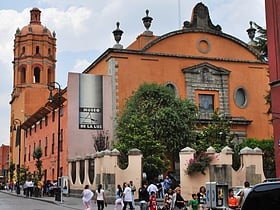Mexico City: Baroque Architecture
Places and attractions in the Baroque architecture category
Categories
- Museum
- Shopping
- Art museum
- History museum
- Specialty museum
- Church
- Park
- Baroque architecture
- Shopping centre
- Modern art museum
- Historical place
- Hispanic colonial architecture
- Market
- Art gallery
- Sacred and religious sites
- Architecture
- Monuments and statues
- Sport
- Sport venue
- Amusement park
- Concerts and shows
- Amusement
- Neighbourhood
- Nightlife
- Area
- Amusement ride
- Flea market
- Archaeological museum
- Entertainment
- Library
- Arenas and stadiums
- Science museum
- Theater
- Art Nouveau architecture
- Palace
- Square
- Archaeological site
- Theme park
- Concert hall
- Dancing
- Natural attraction
- Nature
- Ruins
- Street
- Farmer's market
- Skyscraper
- Music venue
- Performing arts
- Unesco
- Cemetery
- Restaurant
- Football
Palacio Nacional
Palace with government offices Nestled in the heart of Mexico City, the Palacio Nacional stands as a testament to the nation's rich history and cultural heritage. This grandiose building, located on the east side of the Zócalo, the city's main square, has been a key witness to the unfolding of...
Mexico City Metropolitan Cathedral
Grand cathedral with a storied past The Mexico City Metropolitan Cathedral stands as a monumental emblem of faith in the heart of Mexico City, Mexico. This magnificent church, the largest cathedral in the Americas, is a blend of architectural styles, predominantly Baroque and Neo-Classical, reflecting...
Colegio de Santa Cruz de Tlatelolco
Nestled in the heart of Mexico City, the Colegio de Santa Cruz de Tlatelolco holds a distinguished place in the history of education in the Americas. Established in the 16th century, this institution was the first and one of the most important schools for higher...
La Casa de Madero
La Casa de Madero stands as an emblem of spiritual heritage and architectural beauty in the bustling heart of Mexico City. This Catholic church, with its rich history and cultural significance, offers a tranquil haven for both the faithful and tourists alike amidst the...
Palacio de Iturbide
Baroque palace from the late 1700s The Palacio de Iturbide, a magnificent building nestled in the heart of Mexico City, stands as a testament to the rich cultural tapestry and architectural heritage of Mexico. Originally constructed in the 18th century, this grandiose palace was built for the Spanish...
Antiguo Colegio de San Ildefonso
Art museum and cultural center with murals Colegio de San Ildefonso, currently is a museum and cultural center in Mexico City, considered to be the birthplace of the Mexican muralism movement. San Ildefonso began as a prestigious Jesuit boarding school, and after the Reform War it gained educational prestige again as National Preparatory School.
Church of Santa Inés
The Church of Santa Inés is a church located at 26 Moneda Street, just northeast of the Zócalo, Mexico City, Mexico. The building, formerly part of the Convent of Santa Inés, is considered to be a mix of styles between Mexican Baroque and Neoclassical. The church was completely finished in 1770.
Museo Nacional de las Culturas
The Museo Nacional de las Culturas is a national museum in Mexico City dedicated to education about the world's cultures, both past and present. It is housed in a colonial-era building that used to be the mint for making coins. Prior to this, the site was the home of the location of the Moctezuma's Black House.
Convent of La Merced
The Convent of Nuestra Señora de La Merced was a Roman Catholic colonial religious complex in present-day Historic center of Mexico City, that was destroyed to give more space to future buildings.
Palace of the Viceroy
The National Palace is the seat of the federal executive in Mexico. Since 2018 it has also served as the official residence for the President of Mexico. It is located on Mexico City's main square, the Plaza de la Constitución.
Palace of the Inquisition
The Palace of the Inquisition stands on the corner of República de Brasil and República de Venezuela streets in Mexico City, Mexico. As neither side of the building faces Santo Domingo Plaza, the entrance is placed at a canted corner to face the plaza.
La Santísima Church
La Santísima Church is located 12 La Santísima Street at corner of Emiliano Zapata Street in the historic center of Mexico City. Its full name is Church and Hospital of the Most Holy Trinity. The church was built between 1755 and 1783 as a temple for the adjoining hospital/hospice for priests.
Corpus Christi Church
The Corpus Christi Church is a former church on Avenida Juárez in the Historic center of Mexico City. It is the only remaining part of the Convent of Corpus Christi, founded in 1724 for Indian women and which was closed as part of the Reform Laws.
Museo de la Caricatura
The Caricature Museum is located in an 18th-century Baroque building in the historic center of Mexico City. It was opened in 1987 to preserve and promote the history of Mexican cartooning, done for both political and entertainment purposes.
Church of San Felipe Neri "La Profesa"
The Church of San Felipe Neri, commonly known as "La Profesa", is a Roman Catholic parish church that was established by the Society of Jesus late in the 16th century as the church of a community of professed Jesuits.
Santo Domingo
Santo Domingo in Mexico City refers to the Church of Santo Domingo and its Plaza, also called Santo Domingo. Both are located three blocks north of the Mexico City Metropolitan Cathedral following República de Brasil Street with Belisario Dominguez Street separating the two.
Nuestra Señora de Loreto Church
The Nuestra Señora de Loreto Church in the historic center of Mexico City was the last major church constructed during the colonial period. Constructed between 1806 and 1819, the church tilts significantly to one side due to being constructed of stone of two different weights.
Regina Coeli Convent Church
Regina Coeli Convent Church is a Roman Catholic parish church and former convent built in the historic center of Mexico City, on the corner of Regina and Bolivar Streets. The church building is the only functioning portion of a former 16th century convent.
La Enseñanza Church
La Enseñanza Church is located on 104 Donceles Street in the historic center of Mexico City. The Mexican Churrigueresque style of this church, especially that of its altarpieces, is upheld as the pinnacle of the Baroque period in Mexico, as this style soon gave way to the Neoclassic shortly after this church was built.
Church of San Bernardo
The Church of San Bernardo stands at the corner of Avenida 20 de Noviembre and Venustiano Carranza Street just south of the Zocalo or main plaza of Mexico City. It was part of a convent of the same name that was founded in 1636, but was closed along with all convents and monasteries during the La Reforma period in 1861.
Cathedral of Our Lady of Valvanera
The Cathedral of Our Lady of Valvanera is located southeast of the main plaza, or Zocalo, of Mexico City on the corner of Correo Mayor and Republica de Uruguay in the historic center. The church originally belonged to the Convent of Santo Niño Perdido which was founded in 1573.
Colegio de San Ignacio de Loyola Vizcaínas
Colegio de San Ignacio de Loyola Vizcaínas is a non-profit educational institution which was established in the mid 18th century in a Baroque building that occupies an entire city block in the historic center of Mexico City.
San Pedro y San Pablo College
The San Pedro y San Pablo College is a colonial church and former Jesuit house, built in the late 16th and early 17th centuries, located in the historical center of Mexico City, Mexico.
Map

